|
1.
CENTRAL/ WEST AFRICA
Log prices firm up
Confirming price forecasts at end-February, there have
been higher export prices for logs of a limited number of
selected West African species. Reports indicate a shortage
in supply has enabled producers to ask for higher prices as
buyers look for sufficient volumes to make shipments
viable. Almost all demand is from India and China,
although Vietnam is still an active buyer for its steadily
expanding furniture manufacturing companies. In these
market conditions, price movements tend to be much
larger than in more stable times and this applies to losses
as well as (what may be temporary) gains.
Lumber prices have not yet shown any changes following
increases in log prices, but business for sawn and
processed lumber has been very low, with many mills still
closed or working only at low capacity, and with little
improvement forecast for Europe in the second and third
quarter. As a consequence, sawmills are unlikely to
successfully push for price rises in the short-term. Sapele
lumber is an exception and prices in the region have been
very weak with low or no demand from European buyers.
UK reports are of importers and merchants selling existing
stocks of sapele and other tropical hardwoods at below
replacement prices when losses from the falling value of
the British pound are taken into account. Both the UK
pound and the euro have fallen heavily against the US
dollar, making stock replacement values seem high in
comparison to prices paid last autumn.
The currency factor does favor West African producers
who sell in euros against Far East prices in US dollars.
This has given some confidence to West African
producers despite the recent downfalls of prices for some
major species. As the second quarter approaches there is
little prospect of reviving European demand and exports to
China.
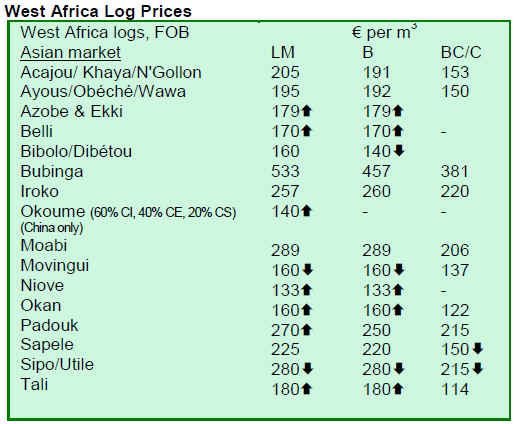
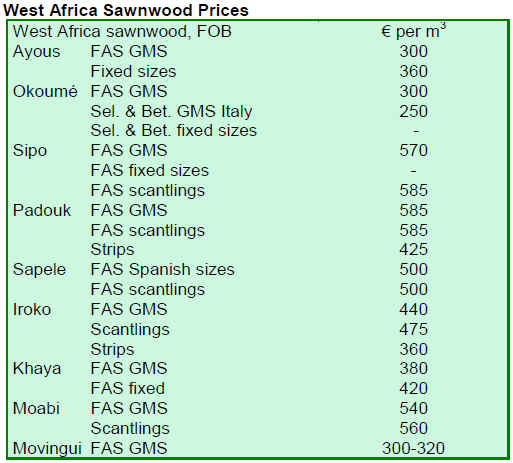
2. GHANA
Ghana¡¯s wood products show marginal rise
During the period January to December 2008, Ghana
exported 20 wood product items with a total volume of
545,910 m³. Compared to the corresponding period in
2007, Ghana¡¯s timber and wood products exports
increased 3.3%. Revenue from these wood products rose
1.3% to EUR186.6 million in the corresponding period.
The table below shows Ghana¡¯s timber and wood products
exports for the January to December period in 2007 and
2008:
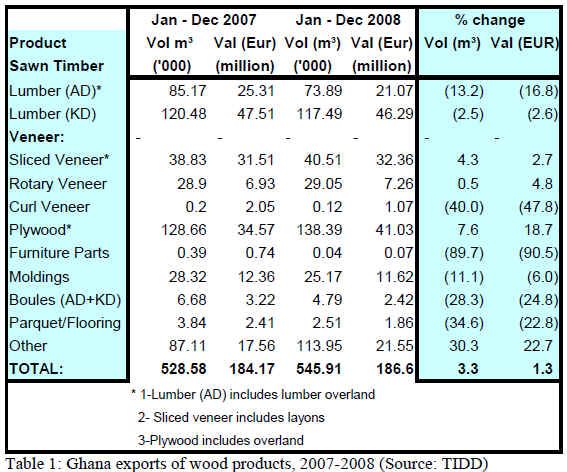
From January to December 2008, plywood exports were
EUR41.03 million, based on a volume of 138,390 m³.
During the corresponding period in 2007, plywood exports
were registered at 128,660 m³ by volume and worth
EUR34.57 million. Based on these figures, plywood
exports for 2008 jumped 7.6% by volume and 18.7% by
value compared to 2007 levels. Overland exports to
neighboring countries were 124,257 m³, accounting for
89.8% of the total plywood exports for the period and
contributing 89% to the total export value. Nigeria was the
largest importer of Ghana¡¯s plywood exports, accounting
for about 74.6% by volume and 80.7% by value. Naja
David Veneer, John Bitar &Co Ltd, Samartex Timber and
Plywood and Ghana Prime wood were among the leading
exports of plywood, with the main species being ceiba,
mahogany, chenchen, asanfina and ofram.
For the period January to December 2008, rotary veneer
exports were 29,050 m³ and valued at EUR7.26 million.
Comparing figures from 2007 and 2008, veneer exports
were 0.5% higher by volume and 4.8% by value. The
leading species were ceiba, essa, otie and koto/kyere. The
US continued its dominance as the largest destination of
Ghana¡¯s rotary veneer exports, as it received 11.45%
(19,290 m³) and 8.4% (EUR4.49 million) of overall total
exports for the period under consideration. India, Canada
and Spain were also major import destinations for Ghana¡¯s
rotary veneer.
In January to December 2008, kiln dried lumber exports
generated EUR46.29 million from a recorded volume of
117,490 m³. During the same period in 2007, kiln dried
lumber exports earned EUR47.5 million from a volume of
120,480 m³. Correspondingly, 2008 kiln dried exports in
2008 fell 2.5% by value from the previous year, indicating
a shift in production. During the period, exports of airdried
lumber recorded a volume of 73,890 m³ and were
valued at EUR21 million, registering decreases of 13% by
volume and 16.8% by value over the same period in 2007.
For the period under consideration, 102 exporters sent
about forty-four timber species to 48 countries. Wawa,
mahogany, koto/kyere, odum and ofram were some of the
leading species exported to the US, Germany, the UK and
Saudi Arabia. Of the 45 countries largely from Asia,
Africa, Europe and the US, India alone accounted for
46.9% of total exports, contributing EUR8.7 million
(42%) to the total value of Ghana¡¯s wood products
exports.
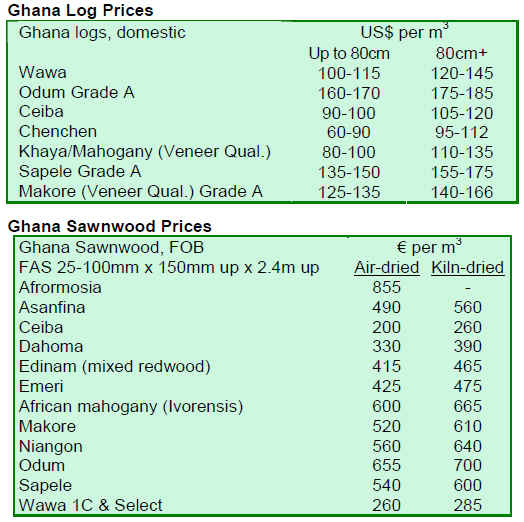

3.
MALAYSIA
Ministry of Finance may provide rebates to furniture exporters
Malaysia¡¯s Plantation Industries and Commodities
Minister Datuk Peter Chin Fah Kui recently submitted a
proposal to the Ministry of Finance to provide rebates to
Malaysian furniture exporters as the export market
continues to dry up. The BTimes reported the proposal is
modeled on the Chinese government¡¯s decision to give
rebates of between 11% and 13% to a variety of Chinese
furniture exporters. Chin noted the proposal was
important, since the furniture industry provides the highest
added value to the local timber industry.
Mr. Chin also forwarded an appeal to the Ministry of
Finance to waive import duties on furniture parts and
components. Presently, import duties are imposed on
furniture parts and components. However, import duties
are not imposed on fully assembled furniture. Thus, prices
of Malaysian furniture exports remain uncompetitive in
the current market.
Minister Chin added that the ministry was also looking
into the possibility of issuing work permits for foreign
workers to be exchangeable between different furniture
factories. The local furniture industry is highly dependent
on cheap foreign labor as it is highly labor intensive and
work permits issued are not transferable. This creates an
added labor cost to companies as they must bear the cost
for new work permit applications.
MIFF flooded with constructive messages
According to Bernama, Deputy Ministry of International
Trade and Industry Jacob Dungau Sagan said the
Malaysian furniture industry should target higher end
markets to weather the global economic downturn, during
his remarks at the recent Malaysian International Furniture
Fair (MIFF) 2009. He noted that Malaysia¡¯s total furniture
trade stood at RM10.17 billion at end 2008, a 3% increase
over 2007. Furniture exports stood at RM8.7 billion, an
increase of 2% compared to 2007 levels.
Although it was hoped MIFF 2009 would generate sales of
at least the same amount as in 2008, the publication
Furniture Today reported that massive floods hit the area
surrounding the venue late in the day on 3 March 2008.
Despite the floods, almost all exhibitors were moved into
another exhibition center unaffected by the floods the next
day and the fair continued. MIFF 2009 was set to be held
from 3¡ª7 March 2009, at the Putra World Trade Center
(PWTC) and MATRADE Exhibition and Convention
Center (MECC).
Malaysian timber exports fall to 28-year low
Timber traders and market analysts believed that exports
of Malaysian timber products could be cut by 40% to 60%
in the current year. The Star reported the possibility of this
trend as Malaysian exports fell by 27.8% in January 2009,
registering RM38.3 billion when compared to January
2008. The figures showed the worst decline in 28 years.
Traders do not expect the market to recover before
December 2010.
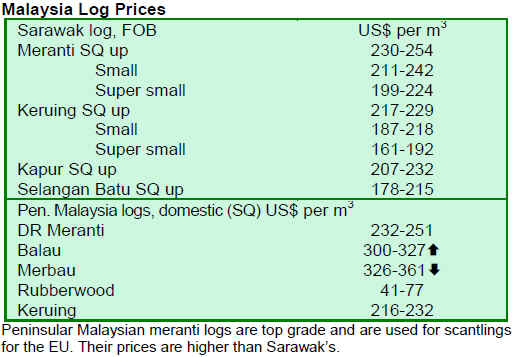
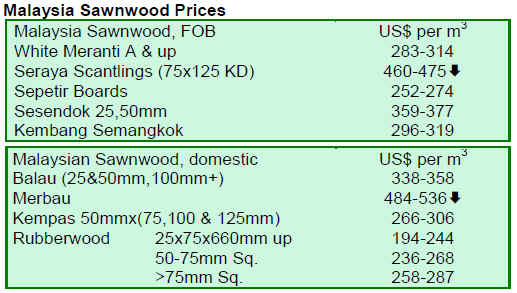
4.
INDONESIA
Plywood industry in Indonesia braces for 40% decline
The Indonesian plywood industry is facing the grim
prospect of a further decline in exports by at least 40% in
2009, according to Mr. Abbas Adhar, Deputy Chairman of
the Association of Indonesian Wood Panel Producers
(Apkindo). With major importing countries such as the
US, the EU and Japan in recession, Indonesian plywood
manufacturers have yet to receive any orders to date for
2009, reported The Jakarta Globe.
The Indonesian plywood industry hit its peak in 1993,
when Indonesian plywood manufacturers employed up to
455,500 workers and manufactured 10 million m³ of
plywood, with 90% heading to export markets. Since then,
production has declined to 3.1 million m³ in year 2008, a
drop of 27% compared to 2007. In 2008, 2.5 million m³ of
plywood, worth USD1.5 billion was exported from
Indonesia.
The industry¡¯s problems are further compounded by aging
machinery and high production costs. Of the 130 existing
plywood factories in Indonesia, only 64 were operating in
2008. This may be further reduced to 20 in 2009. Stiff
competition from China, Malaysia and Brazil was another
major contributor to declines in Indonesia¡¯s plywood
sales. Mr. Masyhud, head of the Ministry of Forestry¡¯s
information center, has suggested Indonesian plywood
manufacturers focus on the local market given the current
economic situation.
Furniture and handicraft manufacturers forecasting a
15% increase in exports
Furniture and handicraft manufacturers in East Java are
forecasting a 15% increase in exports in 2009, as massive
closures of similar manufacturers in China are taking
place. To fill the gaps in production and supply left by
Chinese firms, the Indonesian Furniture and Handicraft
Producers Association (Asmindo) is lobbying former
clients of Chinese exports to buy Indonesian products,
according to Mr. Oetarjo Hariohoehojo, provincial
chairman of Asmindo.
As reported in his remarks in The Jakarta Post,
Hariohoehojo said 40% of Indonesia¡¯s furniture exports
originated from East Java, of which 35% were exported to
Europe, 29% to the US, 9% to Japan and 37% to Africa
and the Middle-East. Exports of furniture and handicrafts
from East Java were USD456 million in 2005 and
USD477 million in 2006. However, exports declined to
USD355 million in 2007 and USD345 million in 2008.
In addition, Gulf Cooperation Council countries are still
importing Indonesian products. Given this demand,
Asmindo will assist Indonesian furniture and plywood
manufacturers to obtain green certification from importing
countries via the verification of legal origin (VLO) process
in order to enhance Indonesia¡¯s environmental and human
rights credentials.

5.
MYANMAR
New orders trickle through Myanmar ports
Ahead of the upcoming tenders on 30 March, the market
was showing little activity, unlike in previous years. Local
traders say that new inquiries are still coming in small
quantities but do not materialize into purchases. Only
those traders dealing with teak (especially non-plantation
teak) continue to experience active trading in the market.
Nevertheless, they too are treading softly, uncertain of
how the markets will behave the coming months. The
situation is particularly concerning to those making a
livelihood in the timber business.
Before the economic crisis, shipments of teak logs, nonteak
hardwood logs and secondary processed wood
products averaged roughly 85,000 tons per month. After
the crisis, the amount dropped to 32,000 and in January
2009 was only 15,000 tons. In February 2009, the volume
was back up to about 37,000 tons, as buyers rushed to
make as many shipments as possible while MTE was still
handling cargo and shipping documentation. MTE is
expected to stop shipping cargo after 15 March. Traders
are planning to assess the effects of trading in the fiscal
new year in April 2009, after ¡®Ex-Works¡¯ sales are in
force.
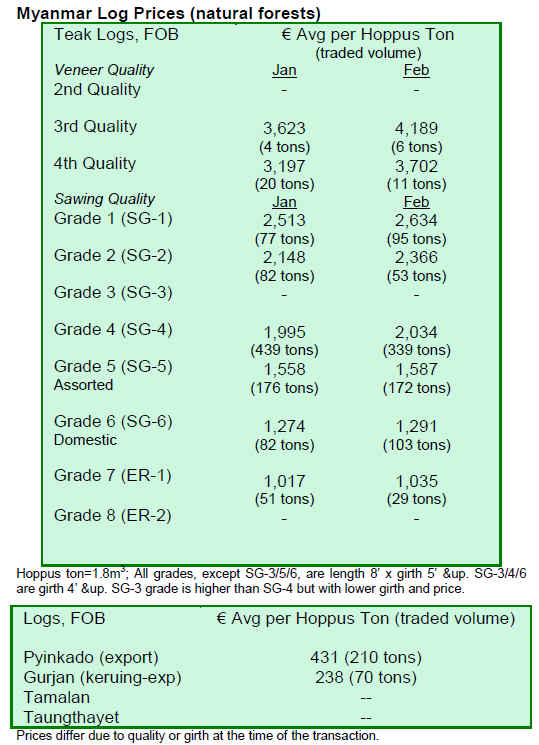
6. BRAZIL
New forest bill to harmonize field inspections
The governor of the state of Mato Grosso is considering a
draft bill for an environmental law addressing the state¡¯s
forest management practices, reported S¨® Not¨ªcias. The
main purpose of the bill is to harmonize standards used in
field inspections carried out by the Secretariat of the
Environment (SEMA) and the Brazilian Institute for
Environment and Renewable Resources (IBAMA). The
draft bill, which was drafted by the Public Prosecutor¡¯s
Office, would regulate statewide forest management
practices and outline approaches for selective logging for
industrial timber practices in 50 areas to verify forest
management plans. The draft bill is a result of about
thirteen consultations held with SEMA and the state
Attorney General¡¯s Office to ensure the text was adjusted
to take into account existing legislation.
The state aims to keep total control of timber by
establishing forest management plans along the chain of
custody. As forest management allows sustainable forest
use, the same forest area may be utilized within 25-year
cycles. Timber sector representatives have observed
problems in the current system such as difficulties with
forest management operations and the identification of tree
species. For instance, trees are sometimes identified
differently in successive inspections. As a result, a timber
company could end up being sanctioned twice, both by
SEMA and IBAMA under the current inspection process.
The harmonized procedure proposed by the draft bill
intends to make timber inspections and operations easier.
Illegal timber sales reach BRL200 million
According to figures based on a partial audit of so-called
¡®Ghost Hunting¡¯ operations coordinated by IBAMA in
Par¨¢ and SEMA, the state of Par¨¢ in the Brazilian
Amazonia traded around BRL200 million in illegally
harvested timber over the past two years. This figure may
reach BRL500 million in the coming days and billions in
the coming months, reported Di¨¢rio do Par¨¢.
At least 50 companies registered with the National
Registry of Private Companies (CNPJ) are considered
¡®ghost¡¯ companies set up falsely to conceal illegal timber
operations. Inspection teams visited select locations listed
in the National Registry, finding that companies registered
as legal timber companies were operating as other
businesses, such as auto repair shops, or were unoccupied
estates. The ¡®ghost¡¯ companies concealed more than
40,000 m³ of timber using seemingly legal invoices issued
in Par¨¢ and in other states of the region. This problem was
identified based on documents from two information
systems, the Sisflora (Forest System) of SEMA, and a
Document of Forest Origin (DOC) of IBAMA.
The inspection team requested the president of IBAMA to
send a task-force to strengthen the ¡®ghost hunting¡¯
operation. No entrepreneur or representative of the
inspected companies has yet to be arrested on charges of
fraud. Nevertheless, the companies are expected to be
penalized under the Environmental Crime Law.
Furthermore, the inspection team expects to send formal
complaints regarding those involved in the scheme to the
Federal Public Prosecutor¡¯s Office.
Wood product exports drop in Alta Floresta
S¨® Not¨ªcias reported on the municipality of Alta Floresta¡¯s
wood products statistics for the month of January 2009.
The municipality reported a significant drop in forest
product exports, with the Ministry of Development,
Industry and Foreign Trade (MDIC) reporting exports of
USD979,000 in January 2009, 38.8% lower than the
registered trade in January 2008. The largest exported
share of timber products in January 2009 were nonconiferous
timber products, equivalent to USD915,6000,
USD1.2 million less or 23.7% lower than in January 2008.
Out of the total sale of products, cedar sawnwood/sliced
veneer generated USD36,900 and ipe sawnwood/sliced
veneer sales were worth USD27,200. Exports to the US,
the main destination of the municipality¡¯s trade in January
2009, were USD692,000. Exports to Spain were
USD128,400, decreasing nearly 68% when compared to
exports to the country in January 2008.
ABIMAD Fair yields positive results
The Brazilian Association of Fine Furniture and
Decoration Accessories (ABIMAD) fair took place in Sao
Paulo, Brazil, between 12-15 February 2009. A total of 35
international buyers attended the event, after participating
in an ¡®international business meeting¡¯ promoted by
ABIMAD and APEX-Brazil. The business meeting was
attended by 35 importers and 45 Brazilian manufacturers
that presented information on their products. Most
international buyers were from South American countries
such as Argentina, Ecuador, Peru and Paraguay as well as
from South Africa, China, Algeria, Costa Rica and the US.
Despite the fluctuation of the US dollar against the
Brazilian real, importers made significant purchases at the
ABIMAD fair. The turnover from the event was near
USD2 million in sales. Many business deals were
negotiated during the fair and at several meetings resulting
from the business round. About USD1.2 million in
furniture trade sales resulted from the fair in 2009.
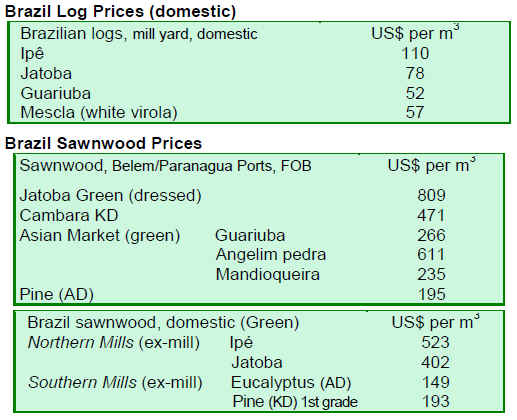
7.
PERU
Environmental Minister notes satisfaction with new
Forest Law
Antonio Brack Egg, Peru¡¯s Environment Minister, said the
recent changes to Peru¡¯s Forest Law would help reverse
the slash and burn approach to clearing forests. He also
noted the new law would prevent forested areas from
being cleared for agricultural purposes, unless the Ministry
of Environment gives its specific approval for the activity
and supervises its implementation.
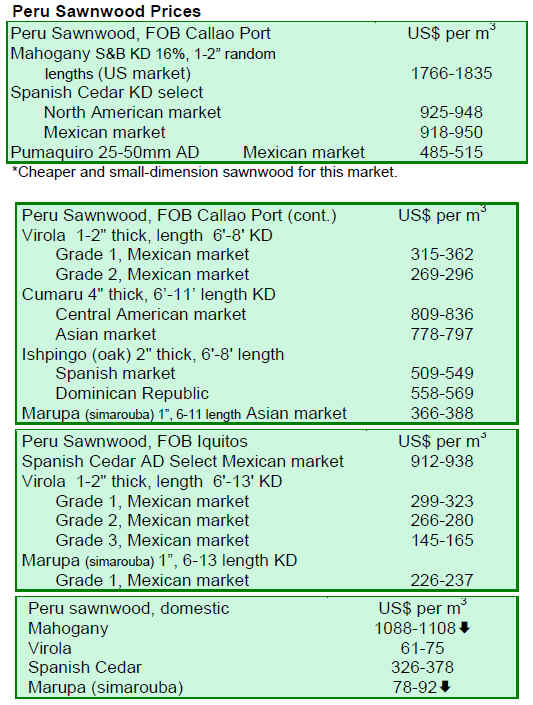
8. BOLIVIA

9.
Guyana
Guyana¡¯s exports continue to show positive trends
With the exception of plywood exports, North American
markets have shown strong signs of growth by value
during the period 01 January to 28 February 2009 when
compared the same period in 2008. When comparing the
two periods, sawnwood exported to the US increased 69%
by value and earned a higher average price by 88%. For
roundwood, volumes declined but values jumped 8% and
average prices rose 89% when comparing the two periods.
A significant increase in average prices paid for Guyana¡¯s
shingles by the US market were also recorded over the
corresponding period.
Average prices for logs and sawnwood exported over the
previous fortnight decreased when compared to the same
period in 2008. This was primarily the result of the larger
exported volumes of the lesser valued species over the
fortnight and dwindling exports of higher priced species.
While the average price levels for roundwood were
maintained, the average price for splitwood recorded a
robust 17% increase over the previous fortnight. Other
value-added products, mouldings and outdoor/garden
furniture also recorded higher average prices for the
fortnight when compared to the previous price levels.
While the average price for mouldings jumped 77%, those
for furniture increased 47%.
Guyana moves to cushion forestry sector from financial crisis
The Ministry of Agriculture has stated that several
initiatives were being undertaken to mitigate the impact of
the global financial crisis on the forestry sector.
Agriculture Minister Robert Persaud said one of the
initiatives involved the formation of the Forest Products
Development and Marketing Council, which will lend
essential marketing and trade advice and support to the
forest sector to complement the Guyana Forestry
Commission¡¯s (GFC) work.
He said greater levels of added value exports to Caribbean
markets are being encouraged. Key donor support is also
being targeted to industry development and added value
manufacturing inclusive of quality control and assurance,
efficiency and productivity. In addition, the government
will work to build community and small and medium sized
forest operators¡¯ capacity to cope with increasingly
competitive and often unstable market conditions. The
government will also encourage the targeting of niche
markets (categorized by higher values and small volumes)
instead of commodity markets (large volume markets) and
strong relationships between buyers and sellers.
According to the Minister, Guyana¡¯s wood products
possess a strong chain of custody system, which should be
promoted. The verification of legality of origin has been
brought about by a strong documentation system through
the supply chain, field monitoring, and log tracking
systems. This is a strong point of competitive advantage
for Guyana¡¯s forest products exporters as the international
market is becoming increasingly conscious of the need for
high standards in legal and environmental SFM practices.
He noted that reduction in the costs of fuel will positively
impact production costs. Minister Persaud said the GFC
will continue to monitor external market environments
with the assistance of international partners. The forest
sector in Guyana employs approximately 20,000 to 25,000
persons and its export revenue is around USD55 million to
USD61 million.

|